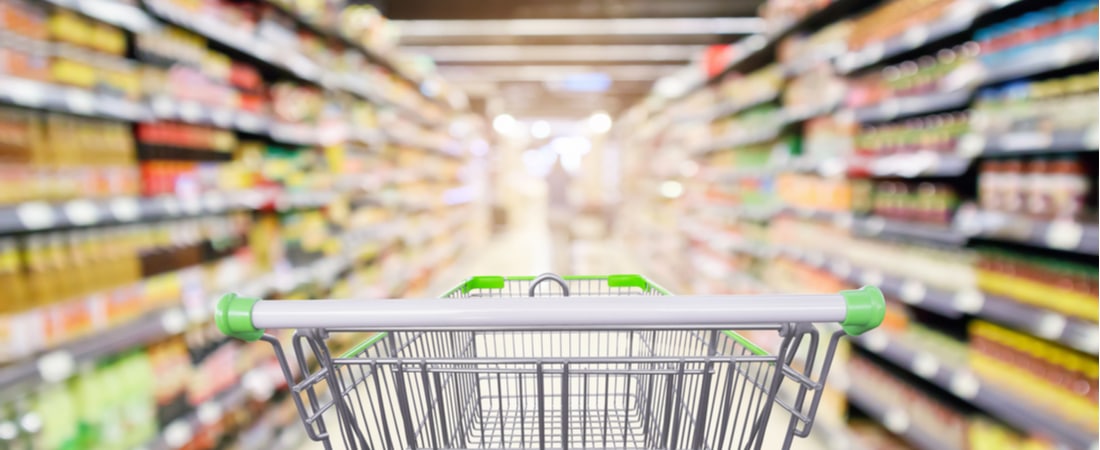How much did Americans spend on groceries during COVID-19? The average weekly grocery bill increased by nearly 20 percent in 2020.
In the early days of COVID-19, grocery store aisles were emptied of pasta, canned vegetables and toilet paper as Americans hunkered down for quarantine. In fact, our publisher, Ilyce Glink, just dug into a big bag of frozen corn that she bought from Costco in the first month of the pandemic (and then tossed it into the freezer, and promptly forgot about it).
Most of those everyday items you use are back in stock now but that doesn’t mean grocery store spending is back to normal.
Grocery Bills During COVID-19: How Much Did Americans Spend During the Pandemic?
The average weekly grocery bill increased by 17 percent during the pandemic, rising from $163 to $190, according to research by LendingTree. A whopping 95 percent of shoppers admitted to overspending on groceries, with 31 percent doing it almost every time they went to the supermarket.
Roughly 40 percent of Americans took fewer trips to the grocery store than they did before the pandemic started and 53 percent went to multiple grocery stores on each shopping trip. More than 60 percent of shoppers ordered food delivery at least once a week (a service that came in handy when reducing contact with people outside the home seemed critical, but could get costly).
Grocery Store Prices During COVID-19
The sharp increase in demand for groceries in April, at the start of the coronavirus pandemic, drove grocery prices higher than they’ve been in 50 years. According to the U.S. Bureau of Labor Statistics, there was an overall grocery price increase of 2.5 percent and varied increases in specific categories, including:
- 16 percent price increase for eggs
- 4 percent price increase for poultry, meat and fish
- 2.9 percent price increase for cereal, baked goods and non-alcoholic beverages
Grocery prices spiked more in some areas than others. Residents in Los Angeles paid nearly 10 percent more for a dozen eggs in July than in January, while residents in Atlanta paid nearly 26 percent more for a pound of bacon and residents in Chicago paid 30 percent more for a pound of ground beef.
Prices have been easing in recent months, but remain well above their pre-pandemic levels as retailers brace for another increase in demand if there’s a surge in coronavirus cases this fall or winter and Americans are required to shelter-in-place once again.
How to Save Money on Groceries During the COVID-19 Pandemic
Although many consumers are doing better financially than at the start of the pandemic, it makes sense to save money everywhere you can. Here are some ideas for saving on your next grocery bill:
- The next time you write out your grocery list take a look at the sales fliers for the stores you’re going to be shopping at and see if you can plan your meals around items that are discounted that week.
- Whenever possible, choose the generic store brand item over the name brand item to save money and when you do need a name brand item, see if you can find a manufacturer coupon to offset the cost.
- Try to build some flexibility into your list, if a certain item you’re looking for is out of stock or overpriced, consider what a good substitute would be so you aren’t caught off guard and tempted to overspend when you’re shopping.
- Most importantly, don’t panic when you’re at the store and start throwing as much as you can into your cart.
If you find yourself feeling overwhelmed when you walk into a grocery store, let go of your cart and take a step back. Leave the aisle and find a low-traffic area to take some deep breaths, review your list and remind yourself why it’s important that you stick to it. After a minute or two, you should be ready to get back at it with renewed determination to save money and buy only what you came to the store to get.
More on Topics Related to How Much Did Americans Spend on Groceries During COVID-19?
Managing Your Personal Finances During COVID-19
COVID-19: Unemployment and the Mounting Financial Crisis
Which Debt to Pay First When Improving Personal Finances
COVID-19 Scams: What to Look for in a COVID-19 Scam
How Will COVID-19 Impact Retirement Planning?







Leave A Comment